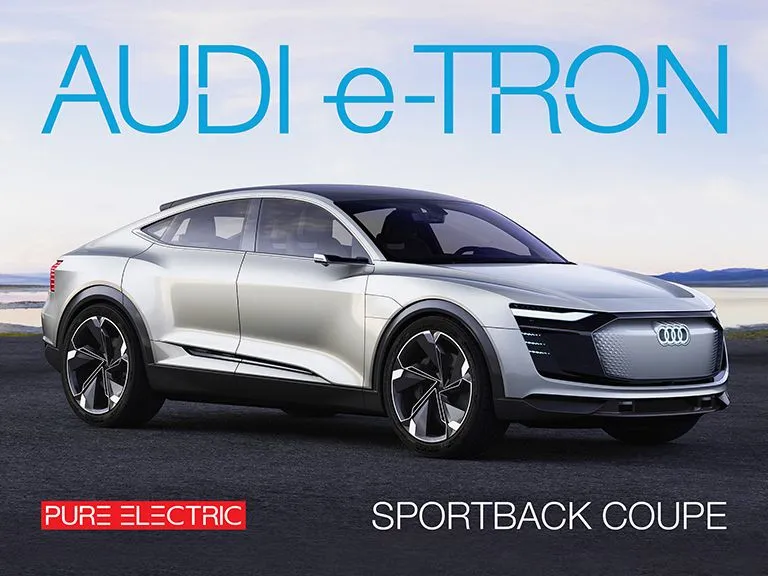
Audi’s second EV for the USA will be an e-Tron Sportback Coupe with a 300-mile 95kWh battery
Audi is getting serious about electrified cars. It has globally launched its next-gen e-Tron and plans to launch 5 all-electric vehicles in China over the next 5 years. Audi has stated plans to release 3 all-electric vehicles in the USA by the end of 2020 (including the 2 e-Trons), but that may or may not happen. The company has announced its second EV to be sold in America will be the e-Tron Sportback Coupe, with more pronounced styling, a slanting roofline and 4 doors. SUV Coupes are selling well and Audi’s keen to get in on the action.
John Coulter, Current EV CMO
When BMW introduced its X6; a high-riding, sportier, more aggressive looking version of a practical family hauler, it was an instant hit. Following suit with its Bavarian rival, Mercedes Benz launched its GLC Coupe in 2008, cementing in place the newly created “Coupe SUV Niche.” Many automakers have jumped on the bandwagon, recognizing the truism discovered by BMW: family haulers don’t have to be large, boxy, boring designs. Sporty, rakish, fastbacks executed with original twists are far more desirable. In the quickly developing e-Mobility car segment, they’re creating a large clientele. Tesla’s Model X, Jaguar’s i-Pace and Audi’s e-Tron SUV are selling well; more of these models will follow. The Tesla Y and e-Tron Sportback Coupe will be two of them.
The e-Tron Sportback Coupe will use a powertrain configuration employed on all its future models with electric drive: A single electric motor on the front axle and two e-motors on the rear axle to power all four wheels. 320kWh of power – increased to 370kWh in Boost Mode – will provide a 4.5 second acceleration to 62mph. The car’s European test ranges have reached 500 kilometers (310.7) miles, though the EPA’s estimated range will be lower because of more stringent American test standards.
The EV’s liquid-cooled lithium-ion battery will be positioned between the axles below the passenger compartment. This installation position provides for a low center of gravity and a balanced axle load distribution of 52:48 (front/rear), creating outstanding driving dynamics and driving safety.
Auto designers are adopting dramatic new airflow strategies for the EVs they’re designing. Fossil-fuel cars require grilles for airflow to help keep their engines cool. With an EV, this isn’t necessary. The e-Tron Sportback’s solid octagonal Singleframe front has been painted the same color as the body and is sculpted with a bridge running parallel with the nose that connects with the wheel arches and deflects air flow.
A new trend: small cameras replace exterior mirrors, offering improved airflow and wind noise reduction. Physical mirror blind spots have been eliminated this way. The camera images are shown on separate displays in the doors.
Inside the light-colored minimalistic cabin, functional clarity and reductive controls create Audi’s new formal principle for its EV interiors. Large, touch-sensitive screens display important driving and on-board systems info. There are four of them:
• an all-digital instrument cluster behind the steering wheel
• a generously large touchscreen for the infotainment system
• a touchscreen for controlling heating, ventilation and AC
• a thin, wide screen above the glove box displaying weather, time and multimedia info details
One of the most unique characteristics of the e-Tron Sportback will be its innovative new lighting technology. Audi was the first carmaker to use full LED headlights and create a lighting system employing Matrix LED technology, laser lighting and OLED technology. The e-Tron Sportback’s lighting systems will offer new possibilities for creating animated communication with other cars, for generating visual welcome signals when the car’s doors are opened, and for generating communicative signs – operations like turning and braking – while the car is on the move. All this will be accomplished by light strips on the car’s front and back comprising large-area light fields which use LED arrangements. This new communication with lights will become even more important for the future, when cars become self-driven. It will be one of the many ways self-driving cars talk to one another and alert each other.
The e-Tron Sportback will be built at the same new Brussels plant which is producing its e-Tron predecessor. When the car will debut in the USA hasn’t been announced yet.
Recent Posts
- The 2022 Audi Q4 e-Tron SUV combines performance, practicality and luxury
- Ford's 2022 F150 Lightning All-Electric Truck is in high demand
- Legendary Audi performance is at the heart of the 2022 Audi e-tron GT and its RS sibling.
- Meet the Lexus RZ 450e – the luxury brand’s 1st EV
- The 2022 GV60 is Genesis’ first all-electric vehicle

